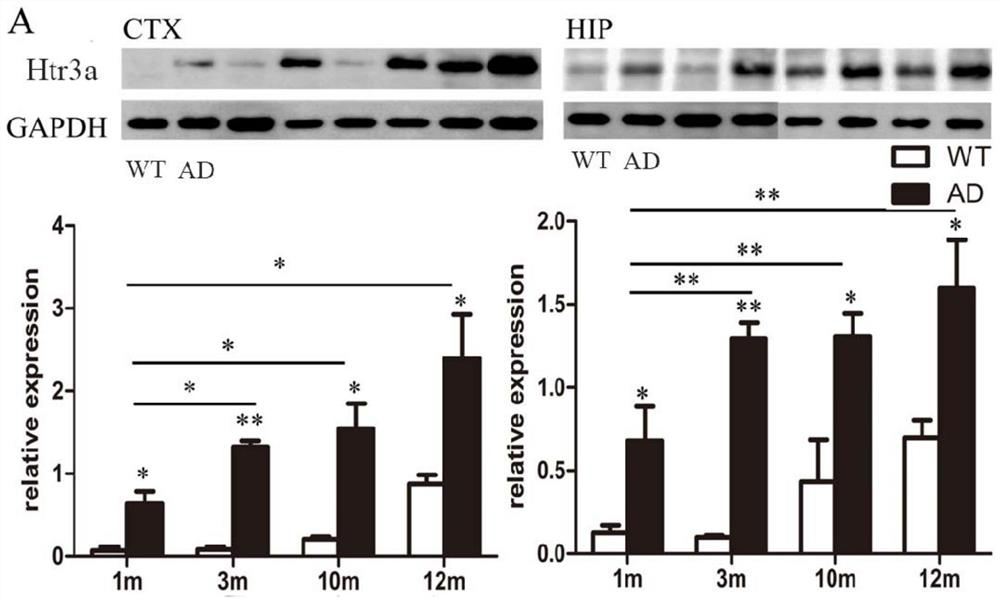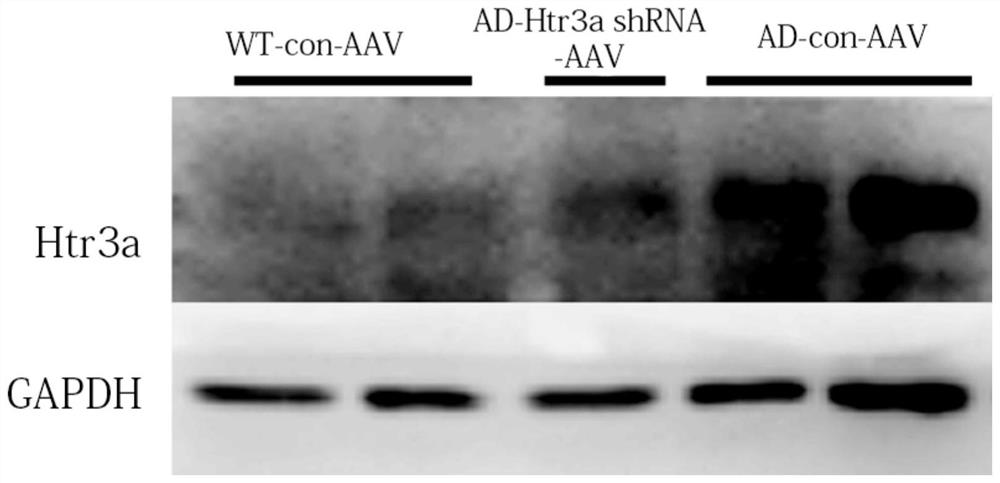Application of compounds inhibiting htr3a and its intracellular signaling pathway in the preparation of drugs for treating and/or preventing AD
A technology for intracellular signaling and compounds, applied to compounds that inhibit Htr3a and its intracellular signaling pathways, and the application field of preparing drugs for the treatment and/or prevention of AD
- Summary
- Abstract
- Description
- Claims
- Application Information
AI Technical Summary
Problems solved by technology
Method used
Image
Examples
Embodiment 1
[0066] The APP / PS1 transgenic AD mice used in this experiment (purchased from the Model Animal Center of Southern University) are widely used AD model mice.
[0067] First, through western blot analysis, it was found that the expression of Htr3a in the cortex and hippocampus of APP / PS1 transgenic AD mice from 1 to 12 months was significantly increased compared with wild-type (WT) mice ( figure 1 ); secondly, with immunofluorescence staining, the result analysis showed that there was a significant increase of Htr3a-positive cells in the cortex of APP / PS1 transgenic AD mice in 10 months, while Htr3a-positive cells could hardly be detected in WT mice ( figure 2 ).
[0068] It can be seen that the expression level of Htr3a in APP / PS1 transgenic AD mice from 1 to 12 months is significantly higher than that of wild-type mice of the same age.
[0069] Wherein, in the present embodiment, the concrete method of western blot analysis is as follows:
[0070] Littermates of APP / PS1 AD ...
Embodiment 2
[0074] Silencing Htr3a in APP / PS1 AD mice, and reducing Htr3a observed the effect on amyloid plaques in APP / PS1 AD mice.
[0075] AAV-htr3a shRNA-GFP virus was prepared, and AAV-EGFP empty virus was used as control. Six-and-a-half-month-old WT mice and APP / PS1 AD mice were injected bilaterally into the hippocampus. The experiment was divided into three groups: (1) WT mice were given the same volume of AAV-EGFP (CON-AAV); (2) APP / PS1 AD mice were given AAV-EGFP (CON-AAV, titer 2.19×10 9 V.G / each side; (3) APP / PS1AD mice were given AAV-Htr3a shRNA-GFP virus (titer: 2.19×10 9 V.G / each side). After the injection, the animals were fed for 4 weeks, overly anesthetized, and the brain tissue was taken for western blot protein hybridization experiment and immunofluorescence staining. Refer to Example 1 for the methods of western blot protein hybridization experiment and immunofluorescence staining.
[0076] Protein hybridization experiments showed that in the Htr3a shRNA-AAV virus i...
Embodiment 3
[0078] Study on whether reducing the expression of Htr3a in APP / PS1 AD mice has any effect on Aβ amyloid
[0079] In order to study whether reducing the expression of Htr3a in APP / PS1 AD mice has an impact on Aβ amyloid, in this embodiment, immunofluorescent staining for Aβ amyloid ( Figure 5 ) and western blot ( Figure 6 ) analysis and thioflavin staining of Aβ amyloid ( Figure 7 ), for the analysis of Aβ amyloid plaques.
[0080] The results showed that Htr3a and Aβ amyloid plaques of APP / PS1 AD mice were significantly reduced compared with AD mice (administered with empty virus).
PUM
 Login to View More
Login to View More Abstract
Description
Claims
Application Information
 Login to View More
Login to View More - R&D
- Intellectual Property
- Life Sciences
- Materials
- Tech Scout
- Unparalleled Data Quality
- Higher Quality Content
- 60% Fewer Hallucinations
Browse by: Latest US Patents, China's latest patents, Technical Efficacy Thesaurus, Application Domain, Technology Topic, Popular Technical Reports.
© 2025 PatSnap. All rights reserved.Legal|Privacy policy|Modern Slavery Act Transparency Statement|Sitemap|About US| Contact US: help@patsnap.com



